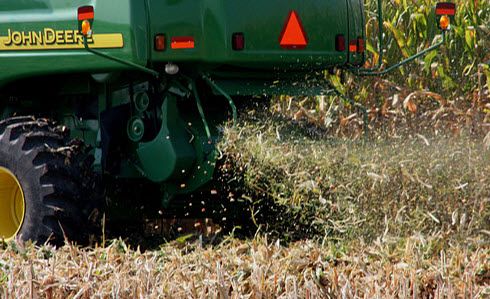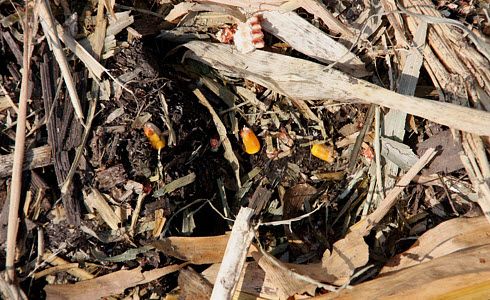Corn yield is effectively set at the R6 stage of kernel development, also referred to as physiological maturity. After that milestone is reached, crop yield cannot be gained, only lost. Weather plays a key role in how much of the yield is eventually captured at harvest. Dry weather is conducive to fast drydown and timely harvest of the crop. Wet weather, on the other hand, can lead to increased stalk and ear rots, potential harvest delays, and increased field losses.
Optimizing combine settings throughout harvest is another important key to achieving highest harvestable yields. This step is critical in order to reduce ear and kernel losses that can occur when combining. Unlike weather conditions, combine settings are completely under the growers’ control.
To optimize harvested yields, growers should:

Corn field losses consist of pre-harvest and harvesting losses. Pre-harvest losses are primarily due to ears dropped from plants. Kernels (rather than whole ears) may also be lost prior to harvest, usually due to hybrid/environmental effects or wildlife damage, but these are relatively rare compared to other causes, and are not discussed here.
Losses prior to harvest are greatest when crop condition deteriorates as the crop stands in the field drying to an acceptable harvest moisture. Wet fall weather delays grain drying and thus subjects the crop to an extended period in the field following maturity. Under these conditions, ears may drop as ear shanks weakened by insect feeding or weathering eventually break at a node, detach from the stalk, or detach from the cob. Dropped ears may or may not include the husks.
Harvesting losses refer to those associated with the combine, and include header, threshing and separating losses.
Header Losses
Header or “gathering” losses usually contribute the most to harvesting losses because whole ears as well as kernels can be lost at the header. Whole ear losses result when:
Kernel losses occur at the corn head because of shelling due to impact by the moving parts (gathering chains, snapping rolls, and cylinder) as well as the stationary parts of the head.
Threshing and Separating Losses
Threshing losses refer to those occurring in the cylinder and concave where corn is shelled from the cob. When kernels remain attached to the cob, they are usually lost out the back of the combine as the crop residue is ejected. Separating losses are unattached kernels that fail to make it into the clean grain stream and so remain in the crop residue as it passes through the chaffer and shoe sieves and is blown out the back of the combine.

Distinguishing Corn Field Losses
To distinguish the causes of corn field losses, a process of pre-harvest and in-harvest steps is necessary. This is because ears can be lost both pre-harvest and at the corn head, and kernels can be lost at the corn head or in the threshing and separating phases of combining. Basically, lost ears must be measured both in front of and behind the combine; and lost kernels must be measured behind the corn head and behind the combine to distinguish their source. Then:
Measuring Pre-Harvest Ear Losses
To measure pre-harvest ear losses, count the number of dropped ears in 100 plants at 3 or more sampling locations in the field. Ears with husks attached will be much harder to detect, especially if there is lodging or crop residue on the ground. Because today’s hybrids planted at their optimum density generally produce one ear per plant, each ear dropped in 100 plants inspected represents about a 1% yield reduction. Multiply the percent reduction by your estimated yield for the field to convert yield loss to bu/acre. If the dropped ears are not full-size ears, convert small ears to normal ear equivalents in making the yield loss calculation (for example, 3 small ears are equal to 2 normal ears).
Measuring Header Losses
To distinguish kernels lost at the header from those lost out the back of the combine, stop the combine and back up about 20 feet. Inspect the area already passed over by the corn head but not by the back of the combine. Inspect a 10 sq. ft. area by dropping a 2 ft. by 5 ft. frame on the ground. 20 kernels found in this area equals approximately 1 bu/acre yield loss.
To measure the header losses incurred due to whole ears lost, count the number of ears dropped in 100 plants behind the combine. Subtract from that the number of pre-harvest ears lost. The remainder represents ears lost at the header. One dropped ear in 100 plants is equal to ~ 1 % yield loss.
Measuring Threshing and Separating Losses
Threshing losses are represented by kernels still attached to cob fragments found behind the combine. Again, count these still-attached kernels found inside a 10 sq. ft. frame opening behind the combine. Each 20 kernels equals approximately 1 bu/acre yield loss.
Yield loss math
Kernels: 20 kernels lost per 10 sq. ft. = ~ 87,000 kernels/acre. One bushel of corn is assumed to contain about 90,000 average-sized kernels.
To determine yield lost during the separating phase of combining, count unattached kernels in a 10 sq. ft. area behind the combine. Subtract from this number the kernels counted in the area passed over by the corn head only. For each 20 kernels in the remainder, approximately 1 bu/acre of yield is lost.

Individual kernels may be lost from either the corn head or out the back of the combine.
Combine settings and operation are critical to minimize harvesting losses. The combine is a complex machine that gathers, threshes, and cleans the grain. Poor combine adjustment can result in not only lost yield, but reduced grain quality as well. When set properly, most combines, both cylinder and rotor types, can do a good job of preserving yield while separating kernels from the non-grain portion of the crop.
Growers are advised to set the combine to manufacturer-recommended settings as a starting point, and then adjust to the condition of the crop. Frequent checking and readjusting can then keep the combine set appropriately to reduce both harvest losses and kernel damage. When crop conditions change during the day, small adjustments may be necessary.
The goal of proper combine settings is to achieve a smooth, even flow of crop material moving through the machine. The combine should run nearly full to minimize impact on the grain. A near-empty machine, on the other hand, leads to multiple contacts of the machine and the grain, which increases breakage.
Gathering snouts: Adjust snouts so that they just touch the ground under normal conditions. If plants are lodged, let snouts float on the ground and reduce ground speed as needed.
Snapping roll and stripper plate spacing: Set snapping roll spacing according to stalk thickness. Set the stripper plates (aka, deck plates or snapping bars) as wide as possible without losing ears or shelling corn off the ear (this reduces amount of stover taken into the machine). Plates should be set slightly narrower (1/8 to 3/16 inches) in front than in back to prevent wedging. If ears are small in diameter due to drought, narrow the stripper plates accordingly so ears are not pulled through and lost.
Ground and snapping roll speed: The ground speed depends on the condition of the crop, but should generally be as fast as possible without plugging the head or threshing mechanism. Snapping rolls should be set relative to ground speed. When set too fast, snapping rolls increase the impact of the ear on the stripper plates. This causes kernels to be shelled and lost, increases breakage of ear butt kernels and results in ear bounce.
Cylinder/rotor and concave: The cylinder or rotor is designed to thresh corn from the cob. It is no surprise then, that cylinder/rotor speed is the leading cause of grain damage by the combine. In one study, increasing the cylinder speed from 300 to 600 rpm increased kernel damage from below 5% to over 30%. However, if threshing is too gentle, unshelled kernels can be lost with the cobs.
Growers should use the lowest possible cylinder/rotor speed that will shell the grain within acceptable loss levels (less than 1% in good-standing fields). To reduce unthreshed losses without increasing grain damage, try decreasing the concave clearance before increasing cylinder/rotor speed. If this does not achieve satisfactory threshing, then begin to increase cylinder/rotor speed as required.
Concave clearance should be set so as to avoid breaking the cobs excessively, which can lead to kernels left on cob fragments. Cobs should only be broken into 3 or 4 pieces for best threshing results and minimal threshing losses.
Separation and cleaning: After threshing, the grain is separated from non-grain crop material by the chaffer and shoe sieves and the cleaning fan. Lighter chaff is blown out the back of the combine, while heavier unthreshed cob segments are returned to the thresher by the tailings system. Screens allow fine grain particles and foreign matter to be removed in the cleaning process.
The goal of separation and cleaning is to achieve a clean, high-quality end product while minimizing grain losses. To accomplish this, sieve and fan settings are critical. If the fan speed is too high, kernels will be lost. If too low, excess foreign material is retained in the grain. Begin with manufacturer suggested settings and check and adjust frequently. Crop conditions, including non-grain crop moisture, can change rapidly during autumn days. Monitor losses behind the combine and grain quality in the grain tank throughout the day.
The dangers of a combine in operation are readily apparent, so don’t take chances! The following safety tips are given by Dr. Mark Hanna, Extension Ag Engineer, Iowa State University (Hanna, 2008).
Hanna, M. 2008. Profitable corn harvesting. Extension publication PM 574. Iowa State University, Ames, Iowa.
Sassenrath, G. et al. 2018. Strategies for improving corn harvest efficiency. In Agronomy eUpdate Issue 704. Kansas State University, Manhattan, Kansas.
PIONEER ® brand products are provided subject to the terms and conditions of purchase which are part of the labeling and purchase documents.